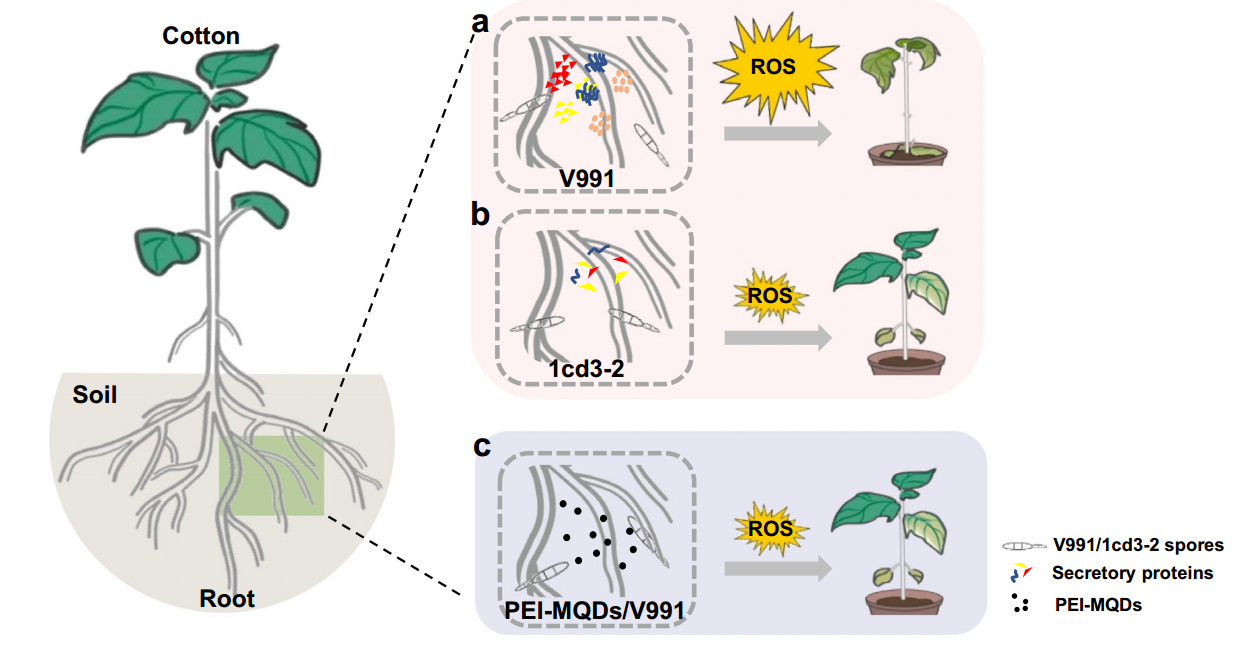南湖新闻网讯(通讯员 邱萍)近日,作物遗传改良全国重点实验室、植物科学技术学院张献龙教授领衔的棉花遗传改良团队研究成果以“Polyethyleneimine-coated MXene quantum dots improve cotton tolerance to Verticillium dahliae by maintaining ROS homeostasis”为题在Nature Communications发表。研究发现植物免疫持续激活与活性氧过度积累是黄萎病发生时棉花叶片黄化坏死的重要原因,并提出利用纳米材料缓解棉花黄萎病症状的解决方案。
大丽轮枝菌是造成棉花、橄榄、向日葵等大田作物黄萎病发生的主要病原真菌。病原从幼苗根部入侵,并借由维管束拓展到植株全身造成叶片黄化、坏死,甚至植株死亡。黄萎病发生早期隐蔽性强,难以早发现早预防;病原在植株体内拓展使化学防控有效性差;抗病种质缺乏和抗病机制不明使其成为棉花、橄榄、向日葵等重要经济作物的主要病害,对全球天然纤维和油料生产造成重要影响。尽管真菌致病和植物免疫已被广泛研究,但对于强致病力大丽轮枝菌与棉花互作机制,特别是感病植物叶片黄化、坏死脱落导致植株生长受到抑制甚至死亡的原因仍不清楚。

棉花与大丽轮枝菌的互作模式图
研究通过棉花与大丽轮枝菌互作的长期转录组分析发现棉花与强致病力病原菌株入侵互作时会形成两个明显的反应过程;棉花早期(时期I)会有更多木质素合成相关基因的表达以强化胞壁结构来增强抗性;但在后期(时期2)棉花中木质素代谢受到明显抑制,大量免疫反应相关基因受诱导表达显著增强,植株体内伴随有持续性活性氧(ROS)的产生并造成ROS积累。而弱致病力菌株侵染棉花时,植株体内木质素合成会持续增强;在病原入侵后期叶片中只有很少的ROS产生,也没有出现植物免疫相关基因的大量表达。通过比较基因组发现,强致病力菌株存在大量特异的分泌蛋白,并在时期II高量表达。这些分泌蛋白可能是植物识别病原并诱导持续性免疫反应和ROS积累的原因。通过研究证明一个在强致病力菌株时期II特异表达的分泌蛋白基因SP3对病原的致病力具有重要影响。突变SP3后,病原致病力显著下降,棉花体内活性氧明显减少。因此,研究认为强致病力特有的分沁蛋白在时期II的高量表达诱导棉花免疫的组成型激活和ROS积累可能是叶片黄化、坏死甚至植株死亡的原因。
为证明该假设,研究人员设计并合成了具备良好ROS清除能力的纳米材料聚乙烯亚胺修饰的MXene量子点(PEI-MQDs)。研究发现用该纳米材料处理棉花能显著增强植株叶片过氧化物酶、过氧化氢酶和谷胱甘肽过氧化物酶的活性,显著降低强致病力病原侵染植株时叶片体内ROS的含量,叶片黄化、坏死程度显著减轻。
研究结果表明,强致病力大丽轮枝菌诱导棉花体内免疫持续激活导致过量的ROS积累是黄萎病发生时叶片黄化、坏死等的主要原因,而纳米材料PEI-MQDs的应用通过维持ROS平衡提高了棉花对大丽轮枝菌侵染的耐受性。该研究发现了棉花与大丽轮枝菌互作的规律,揭示了强致病力大丽轮枝菌入侵造成黄萎病叶片症状的分子机制,对棉花黄萎病的防控提出了新的解决方案。
作物遗传改良全国重点实验室、植物科学技术学院博士研究生邱萍、张琳和硕士研究生李佳玥为论文共同第一作者,华中农业大学棉花遗传改良团队朱龙付教授、华中农业大学作物纳米抗逆团队吴洪洪教授和河南大学高巍教授为论文共同通讯作者,张献龙教授等共同参与了研究。研究工作得到了国家自然科学基金、湖北洪山实验室和国家重点研发计划等项目的资助。
此外,根据上述理论研究,利用可诱导棉花免疫提前激活的激发子转化棉花获得了抗病性和产量显著提升的新种质。日前,该研究成果以“The elicitor VP2 from Verticillium dahliae triggers defence response in cotton”为题在Plant Biotechnology Journal发表。
审核人:朱龙付
【英文摘要1】
Verticillium dahliae is a soil-borne hemibiotrophic fungal pathogen that threatens cotton production worldwide. In this study, we assemble the genomes of two V. dahliae isolates: the more virulence and defoliating isolate V991 and nondefoliating isolate 1cd3-2. Transcriptome and comparative genomics analyses show that genes associated with pathogen virulence are mostly induced at the late stage of infection (Stage II), accompanied by a burst of reactive oxygen species (ROS), with upregulation of more genes involved in defense response in cotton. We identify the V991-specific virulence gene SP3 that is highly expressed during the infection Stage II. V. dahliae SP3 knock-out strain shows attenuated virulence and triggers less ROS production in cotton plants. To control the disease, we employ polyethyleneimine-coated MXene quantum dots (PEI-MQDs) that possess the ability to remove ROS. Cotton seedlings treated with PEI-MQDs are capable of maintaining ROS homeostasis with enhanced peroxidase, catalase, and glutathione peroxidase activities and exhibit improved tolerance to V. dahliae. These results suggest that V. dahliae trigger ROS production to promote infection and scavenging ROS is an effective way to manage this disease. This study reveals a virulence mechanism of V. dahliae and provides a means for V. dahliae resistance that benefits cotton production.
论文链接1(Nature Communications):
https://www.nature.com/articles/s41467-023-43192-4
【英文摘要2】
Verticillium dahliae is a widespread and destructive soilborne vascular pathogenic fungus that causes serious diseases in dicot plants. Here, comparative transcriptome analysis showed that the number of genes upregulated in defoliating pathotype V991 was significantly higher than in the non-defoliating pathotype 1cd3-2 during the early response of cotton. Combined with analysis of the secretome during the V991–cotton interaction, an elicitor VP2 was identified, which was highly upregulated at the early stage of V991 invasion, but was barely expressed during the 1cd3-2-cotton interaction. Full-length VP2 could induce cell death in several plant species, and which was dependent on NbBAK1 but not on NbSOBIR1 in N. benthamiana. Knock-out of VP2 attenuated the pathogenicity of V991. Furthermore, overexpression of VP2 in cotton enhanced resistance to V. dahliae without causing abnormal plant growth and development. Several genes involved in JA, SA and lignin synthesis were significantly upregulated in VP2-overexpressing cotton. The contents of JA, SA, and lignin were also significantly higher than in the wild-type control. In summary, the identified elicitor VP2, recognized by the receptor in the plant membrane, triggers the cotton immune response and enhances disease resistance.
论文链接2(Plant Biotechnology Journal):